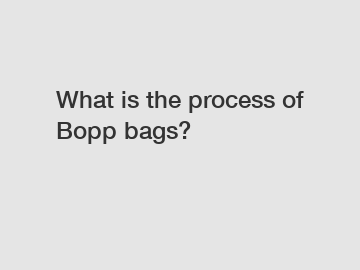What is the process of Bopp bags?
What is the process of Bopp bags?
Bopp bags, also known as biaxially oriented polypropylene bags, are widely used in various industries for packaging purposes. They are durable, resistant to chemicals and moisture, and offer excellent clarity for displaying products. If you're curious about the process involved in manufacturing Bopp bags, read on.
1. Raw material selection:

The first step in producing Bopp bags is selecting the appropriate raw materials. Biaxially oriented polypropylene film is chosen for its exceptional strength and clarity. High-quality raw materials ensure the final product is durable, visually appealing, and capable of preserving the packaged contents effectively.
2. Film extrusion:
The selected polypropylene is passed through an extruder, where it is melted and converted into a molten form. The molten material is then pushed through a die to form a flat film of the desired thickness. This process is known as film extrusion.
3. Biaxial orientation:
After the film is extruded, it undergoes the biaxial orientation process. This involves stretching the film in both the machine direction (MD) and the transverse direction (TD) simultaneously. The stretching is typically done by passing the film through a series of heated rollers that elongate it.
4. Heat setting:
Once the film has been stretched in both directions, it is heat-set to stabilize its dimensions. Heat setting is crucial to prevent the film from shrinking or losing its shape when exposed to temperature changes. The film passes through a series of heated rollers again, which help in retaining the stretched orientation and set the desired size and shape.
5. Printing and customization:
At this stage, the biaxially oriented polypropylene film is ready to be printed and customized according to specific requirements. Printing techniques like rotogravure or flexographic printing methods are commonly used to add branding, product information, or designs onto the film. Various colors and patterns can be applied to enhance the visual appeal of the bags.
6. Lamination and conversion:
To further enhance the bag's strength and barrier properties, a lamination process may be employed. This involves bonding the printed Bopp film to another layer, such as a polyethylene film, using heat and pressure. Lamination improves the bag's tear resistance, enhances its moisture barrier, and provides additional strength for heavy-duty applications.
7. Bag-making:
Once the film is laminated and ready, it is converted into bags using specialized bag-making machines. These machines perform tasks like cutting the film into the desired bag size, sealing the edges, and adding features like handles or resealable closures. The bags are then inspected for quality assurance before being packed and shipped to customers.
In conclusion, the process of manufacturing Bopp bags involves several critical steps, from raw material selection to bag-making. Starting with the extrusion of polypropylene film, it undergoes biaxial orientation, heat setting, printing, lamination, and bag conversion. The result is a versatile packaging solution that offers durability, moisture resistance, and excellent visual appeal. Whether used for food products, textiles, or other applications, Bopp bags provide reliable packaging with efficient protection.
The company is the world’s best bopp wire drawing film, chemi bopp label, bopp vs paper supplier. We are your one-stop shop for all needs. Our staff are highly-specialized and will help you find the product you need.
124
0
0


Comments
All Comments (0)